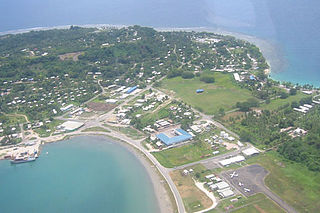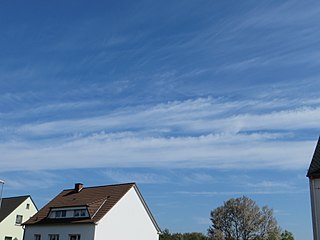
The World Meteorological Organization(WMO) is a specialized agency of the United Nations responsible for promoting international cooperation on atmospheric science, climatology, hydrology and geophysics.
The Bern Convention on the Conservation of European Wildlife and Natural Habitats, also known as the Bern Convention, is a binding international legal instrument in the field of Nature Conservation, it covers the natural heritage in Europe, as well as in some African countries. The Convention was open for signature on 19 September 1979 and came into force on 1 June 1982. It is particularly concerned about protecting natural habitats and endangered species, including migratory species.

In meteorology, Altocumulus castellanus or Altocumulus castellatus (ACCAS) is a cloud type named for its tower-like projections that billow upwards from the base of the cloud. The base of the cloud can form as low as 2,000 metres, or as high as 6,000 metres. They are very similar to cumulus congestus clouds, but at a higher level and with the cloud heaps joined at the base.

Cumulus mediocris is a low to middle level cloud with some vertical extent of the genus cumulus, larger in vertical development than Cumulus humilis. It also may exhibit small protuberances from the top and may show the cauliflower form characteristic of cumulus clouds. Cumulus mediocris clouds do not generally produce precipitation of more than very light intensity, but can further advance into clouds such as Cumulus congestus or Cumulonimbus, which do produce precipitation and severe storms.

Vanimo is the capital of Sandaun Province in north-westernmost Papua New Guinea and of Vanimo-Green River District. It is located on a peninsula close to the border with Indonesia.

Fractus clouds (scuds) also known as Fractostratus or Fracto-Cumulus are small, ragged cloud fragments that are usually found under an ambient cloud base. They form or have broken off from a larger cloud, and are generally sheared by strong winds, giving them a jagged, shredded appearance. Fractus have irregular patterns, appearing much like torn pieces of cotton candy. They change constantly, often forming and dissipating rapidly. They do not have clearly defined bases. Sometimes they are persistent and form very near the surface. Common kinds include scud and cloud tags.
A Regional Specialized Meteorological Centre (RSMC) is responsible for the distribution of information, advisories, and warnings regarding the specific program they have a part of, agreed by consensus at the World Meteorological Organization as part of the World Weather Watch.

Cirrus castellanus or Cirrus castellatus is a species of cirrus cloud. Its name comes from the word castellanus, which means of a fort, of a castle in Latin. Like all cirrus, this species occurs at high altitudes. It appears as separate turrets rising from a lower-level cloud base. Often these cloud turrets form in lines, and they can be taller than they are wide. This cloud species is usually dense in formation.
CLIMAT is a code for reporting monthly climatological data assembled at land-based meteorological surface observation sites to data centres. CLIMAT-coded messages contain information on several meteorological variables that are important to monitor characteristics, changes, and variability of climate. Usually these messages are sent and exchanged via the Global Telecommunication System (GTS) of the World Meteorological Organisation (WMO). Modifications of the CLIMAT code are the CLIMAT SHIP and CLIMAT TEMP / CLIMAT TEMP SHIP codes which serve to report monthly climatological data assembled at ocean-based meteorological surface observation sites and at land-/ocean-based meteorological upper-air observation sites, respectively. The monthly values included usually are obtained by averaging observational values of one or several daily observations over the respective month.

Weather satellite pictures are often broadcast as high-resolution picture transmissions (HRPTs), color high-resolution picture transmissions (CHRPTs) for Chinese weather satellite transmissions, or advanced high-resolution picture transmissions (AHRPTs) for EUMETSAT weather satellite transmissions. HRPT transmissions are available around the world and are available from both polar and geostationary weather satellites. The polar satellites rotate in orbits that allow each location on earth to be covered by the weather satellite twice per day while the geostationary satellites remain in one location at the equator taking weather images of the earth from that location over the equator. The sensor on weather satellites that picks up the data transmitted in HRPT is referred to as an Advanced Very High Resolution Radiometer (AVHRR).

Cirrus spissatus or also called Cirrus densus and Cirrus nothus clouds are the highest of the main cloud genera, and may sometimes even occur in the lower stratosphere. The characteristic features of cirrus clouds are fine threads or wisps of ice crystals, generally white, but appearing grey when dense and seen against the light. There is no precipitation at the ground. It also frequently exhibits optical phenomena.
Administraţia Naţională de Meteorologie or ANM is the Romania government facility of weather prediction. The organisation's headquarters are in Bucharest. The organisation was founded in late 18th century. In 1948 Romania ratifies the 1947 Washington Convention, turning from founding member as a full member of the World Meteorological Organization12. Since 2003 is a member of EUMETSAT with a stake of 0.4456%. Today in Romania, ANM holds the monopoly for meteorological prediction because the state doesn't allow a private carrier in this field. Even if ANM holds monopoly on Romanian market, international media holdings and websites are usually using satellite prediction and the predictions of other meteorological institutions of Romania's neighborough. It is operated by Romanian Ministry of Environment.

Cirrus fibratus or also called Cirrus filosus is a species of cirrus cloud. The name cirrus fibratus is derived from Latin, meaning "fibrous". These clouds are similar to cirrus uncinus, commonly known as "mares' tails"; however, fibratus clouds do not have tufts or hooks at the end. The filaments are usually separate from one another.

Cirrocumulus castellanus or Cirrocumulus castellatus is a type of cirrocumulus cloud. Castellanus is from the Latin meaning "of a castle". These clouds appear as round turrets that are rising from either a lowered line or sheet of clouds. Cirrocumulus castellanus is an indicator of atmospheric instability at the level of the cloud. The clouds form when condensation occurs in the base cloud, causing latent heating to occur. This causes air to rise from the base cloud, and if the air ascends into conditionally unstable air, cirrocumulus castellanus will form.

Cirrocumulus lacunosus also known as Cirrocumulus lacunar or Cirrocumulus lacunaris is a type of cirrocumulus cloud. The term lacunosus is from Latin, meaning "full of hollows". Cirrocumulus lacunosus is a relatively rare cloud form that occurs as a layer of cloud with circular holes in it. Formation is commonly attributed to a cool layer mixing with a warmer, higher layer of the atmosphere. These holes normally have frayed edges, and they are often arranged in a manner that resembles a net or a honeycomb.

Cirrostratus fibratus or also called Cirrostratus filosus is a type of cirrostratus cloud. The name cirrostratus fibratus is derived from Latin, meaning "fibrous". Cirrostratus fibratus is one of the two most common forms that cirrostratus often takes, with the other being cirrostratus nebulosus. They are formed from strong, continuous winds blowing at high altitudes, and they often cover a large portion of the sky. Cirrostratus fibratus may often develop from either cirrus fibratus or cirrus spissatus cloud. Precipitation is often imminent behind these clouds; however, they are not a precipitation-producing cloud.
Hydrologic Research Center (HRC), founded in 1993, is a public-benefit non-profit research, technology transfer, and science cooperation and education organization, dedicated to the development of effective and sustainable solutions to global water issues. HRC's purpose is to provide a conduit for academic and other up-to-date research to be made suitable for effective application to field operational problems that involve water management and flood disaster mitigation. The vision of HRC is to assist in limiting societal vulnerability and preserving resiliency in basic human needs, livelihoods, agriculture, water resources, healthy ecosystems, and natural resources. Around the world flash flooding and flooding are the most common natural disasters and the leading cause of natural disaster fatalities worldwide – 40% of all natural disasters.

Stratocumulus castellanus or Stratocumulus castellatus is a type of stratocumulus cloud, castellanus is derived from Latin, meaning 'of a castle' This type of cloud appears as cumuliform turrets vertically rising from a common horizontal cloud base, these turrets are taller than they are wide

Stratus silvagenitus is a type of stratus cloud, silvagenitus is derived from Latin, meaning "created from forest", this cloud type, as the name implies, forms in forested areas which are experiencing high relative humidity levels, for example, after precipitation has passed, their formation is attributed to evaporation and/or evapotranspiration in forests; if the cloud is uniform, its a stratus silvagenitus cloud, if the cloud is ragged and wispy, then it would be a stratus fractus silvagenitus, these clouds typically form near the ground. the silvagenitus cloud variety only appears in stratus clouds














